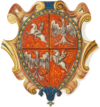Juńczyk coat of arms
| Juńczyk | |
|---|---|
 | |
| Details | |
| Alternative names | Junczyk[1][2] |
| Earliest mention | 13th century |
| Families | Apostoł, Boguszewski, Bohuszewski, Bolesławski, Bołdyk, Bołdysz, Dobrzański, Drohomierecki, Enczyk, Flodzyński, Gomontowicz, Inczyk, Jamont, Jamonth, Jasewicz, Jassewicz, Jucewicz, Juchniewicz, Jucowicz, Juniewicz, Juńczyk, Juński, Pietrykowski, Pietrzykowski, Rostocki, Rostowski, Rzętkowski, Skrutkowski, Szulce, Szulecki, Szyryński-Agiszewicz, Wabiszczewicz, Waskiewicz[2][3][4][5][6][7][8] |
| Juńczyk II | |
|---|---|
 | |
| Details | |
| Alternative names | Junczyk II |
| Families | Boguszewski, Bolbas, Gołub, Krzyżanowski, Rostowski, Turkowski[9] |
Juńczyk (Junczyk, Iunczyk) is a Polish coat of arms. It was used by several szlachta families in the times of the Polish–Lithuanian Commonwealth.
History
The Juńczyk coat of arms was created in the 13th century.[10]
Aleksandr Lakier in his work from 1855 entitled The Russian Heraldry, in the part devoted to Polish heraldry, describes the Juńczyk coat of arms and gives the
following coat of arms legend:[11]
...The origins of this emblem, as well as many others, date back to the times of paganism and its struggle with Christianity. They say that in one battle, when the enemy was with his forces on the bank of the river, a certain Juńczyk, having informed the Christian army of this, led him to the enemy and defeated him, as if he had captured him, on a hook. As a souvenir, Juńczyk received the described coat of arms.
— Alexander Lakier, Russian Heraldry; § 91. End of paragraph: coats of arms: Pomian-Jastrzębiec; no. 268
Blazon
In the red field, a silver double cross torn into a mustache. Gem: five ostrich feathers.[10]
Juńczyk II coat of arms
Blazon
In the red field, a Latin cross torn into a mustache, silver. Jewel: three ostrich feathers.
Gallery
See also
Notes
- ^ "Polona".
- ^ a b Leszczyc, Zbigniew (1908). "Herby szlachty polskiej. T. 1 / Zbigniew Leszczyc ; z przedmową Wacława Gąsiorowskiego". 10000 - Biblioteka Główna Kul.
- ^ "Herby szlacheckie".
- ^ "Herbarz szlachty białoruskiej".
- ^ "R - Herby szlacheckie Rzeczypospolitej Obojga Narodów - Tadeusz Gajl".
- ^ "Польский гербовник А.Бжезина-Винярского".
- ^ "Rody ziemiańskie XV i XVI wieku - Józef Krzepela".
- ^ "Szlachta wylegitymowana w Królestwie Polskim w latach 1836-1861" (PDF). dig.pl (in Polish). Retrieved 14 August 2023.
- ^ "Nazwiska".
- ^ a b "HERBARZ POLSKI". www.hsi.zhp.info. Retrieved 27 March 2023.
- ^ "А.Б. Лакиер. Русская геральдика (1855) / [§ 91. Окончание параграфа; гербы: Помян-Ястржембец]". 16 November 2011. Archived from the original on 16 November 2011. Retrieved 27 March 2023.


